Small Wetlands Filter Pollutants from Irrigated Pasture Runoff
We examined the potential for a functioning wetland and a degraded-channelized wetland to filter pollutants from irrigated pasture runoff at the UC Sierra Foothill Research and Extension Center near Browns Valley, California. The wetlands were approximately 0.5 acres in size, and received tailwater from about 12 acres of pasture. Tailwater runoff rates entering the wetlands ranged from about 0.30 to 1.40 cubic feet per second (cfs).
Functional Wetland
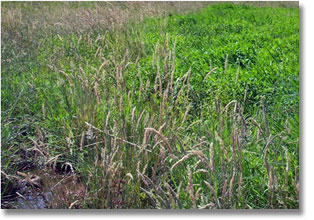
Channelized Wetland
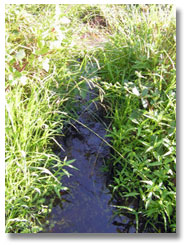
Pasture runoff flowed through each wetland, and we conducted above and below sampling to determine how well each filtered pollutants

Less pollutant load was filtered at high runoff compared to low runoff (flow)
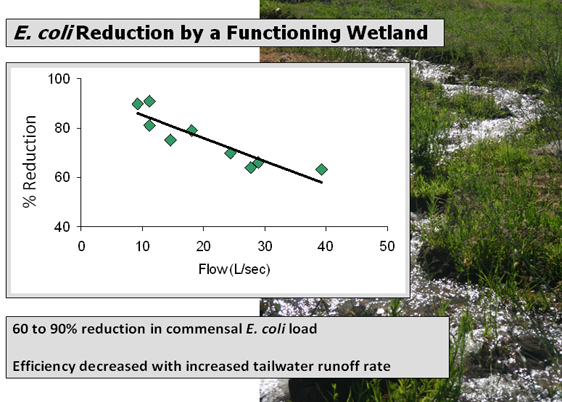
The functioning wetland reduced loads of suspended sediments (TSS), nitrate (NO3-N), and Escherichia coli by 77, 60, and 68%, respectively. Retention of total nitrogen (N), total phosphorus (P), and soluble reactive P (PO4-P) was between 35 and 42% for the functioning wetland. The degraded-channelized wetland was significantly less effective at reducing all pollutants except soluble reactive P. The degraded-channelized wetland was actually a source of sediment and nitrate. Decreased runoff rates (flow) improved retention efficiencies for nitrate, E. coli, and sediments in the functioning wetland.
Results
The functioning wetland reduced loads of suspended sediments (TSS), nitrate (NO3-N), and Escherichia coli by 77, 60, and 68%, respectively. Retention of total nitrogen (N), total phosphorus (P), and soluble reactive P (PO4-P) was between 35 and 42% for the functioning wetland. The degraded-channelized wetland was significantly less effective at reducing all pollutants except soluble reactive P. The degraded-channelized wetland was actually a source of sediment and nitrate. Decreased runoff rates (flow) improved retention efficiencies for nitrate, E. coli, and sediments in the functioning wetland.
Management Significance
Small, functional wetlands can trap pollutants transported in pasture tailwater. Irrigation and pasture management to reduce runoff will increase wetland efficiency for trapping pollutants.
Supporting Information
Knox, A.K, R.A. Dahlgren, K.W. Tate, and E.R. Atwill. 2008. Efficacy of Flow-Through Wetlands to Retain Nutrient, Sediment, and Microbial Pollutants. J. Environmental Quality. 37:1837-1846. Read More
Knox, A.K., K.W. Tate, R.A. Dahlgren, and E.R. Atwill. 2007. Management Reduces E. coli in Irrigated Pasture Runoff. California Agriculture. 61:159-165. Read More
Vegetative Filter Strips Remove Pathogens from Irrigated Pasture Runoff
Annual Rangeland
We have found that annual rangelands are extremely effective at filtering E. coli, C. parvum, and Salmonella during winter rainfall-runoff events.

We found that as plot runoff increased, there was eventually no filtration for filter widths up to 2.1 yards in width when compared to a 0.1 yard filter

Irrigated Pasture
We found that 90+% of E. coli, C. parvum, and Salmonella are either trapped in the cow fecal pat or 0.1 yards below the fecal pat.
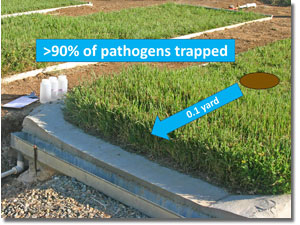

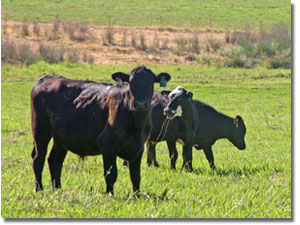
Management Significance
First, it is important to distribute cattle so that fecal pats are deposited away from streams. Fifty percent of fecal deposits are found within 100 yards of cattle attractants such as drinking water tanks, salt blocks, and shade trees (Tate et al. 2003). The risk of microbe transport from pastures can be reduced by careful placement of these attractants away from streams to: 1) keep the fecal pats and microbes out of the water; and 2) create longer distances for microbes to travel – with significant filtering every step of the way.
Second, relatively narrow vegetative filter strips are an option for filtering microbes transported in surface runoff. A few yards can achieve 90 to 99.99% filtration. Distances need to be increased as runoff rates increase.
Supporting Information
Atwill, E.R., L. Hou, B.M. Karle, T. Harter, K.W. Tate, and R.A. Dahlgren. 2002. Transport of Cryptosporidium parvum Oocysts through Vegetated Buffer Strips and Estimated Filtration Efficiency. Applied and Environmental Microbiology. 68:5517-5527. Request Reprint
Atwill, E.R., K.W. Tate, M. Das Gracas C. Pereira, J.W. Bartolome, and G.A. Nader. 2006. Efficacy of Natural Grass Buffers for Removal of Cryptosporidium parvum in Rangeland Runoff. J. Food Protection. 69:177-184. Request Reprint
Tate, K.W., E.R. Atwill, M.R. George, N.K. McDougald, and R.E. Larsen. 2000. Cryptosporidium parvum Transport from Cattle Fecal Deposits on California Rangeland Watersheds. J. Range Management. 53:295-299. Download = tate_JRM_200a
Tate, K.W., E.R. Atwill, N.K. McDougald, and M.R. George. 2003. Spatial and Temporal Patterns of Cattle Feces Deposition on Rangeland. J. Range Management. 56:432-438. Download
Tate, K.W., M. Das Gracas C. Pereira, and E.R. Atwill. 2004. Efficacy of Vegetated Buffer Strips for Retaining Cryptosporidium parvum. J. Environmental Quality. 33:2243-2251. Request Reprint
Tate, K.W., E.R. Atwill, J.W. Bartolome, and G.A. Nader. 2006. Significant E. coli Attenuation by Vegetative Buffers on Annual Grasslands. J. Environmental Quality. 35:795-805. Request Reprint
Vegetative Filter Strips Remove Nutrients from Irrigated Pasture Runoff
We examined how well grass/forb vegetated strips filter nitrogen, phosphorus and carbon pollutants from irrigated pasture runoff at the UC Sierra Foothill Research and Extension Center near Browns Valley, CA.
Part One
Previous studies report higher levels of soluble nitrogen (N) leaving vegetative buffers than entering them. This suggests that buffers can act as a source rather than a sink by releasing previously stored nutrients. We conducted experiments on 19 large irrigated pasture runoff plots (240 m2 or about 240 yd2) to examine field scale pasture runoff response to cattle grazing, flood irrigation at moderate to high rates, and buffer width treatments of 0, 8, and 16 meters (yards). We applied a nitrogen tracer (98 atom % 15N-labeled KNO3) to the plots to quantify buffer efficiency for sequestering new inputs of N.
Large scale (240 yd2) runoff plots were grazed with cattle, flood-irrigated at moderate to high rates, and spiked with a nitrogen tracer (15N) to examine the fate of nitrogen in plots with a 0, 8 and 16 yard wide buffer with and without cutting and removal of buffer vegetation to stimulate growth and N uptake.
We found more N was lost from the non-buffered treatments than from the buffered treatments. The majority of the N attenuation was by vegetative uptake.

We found significant reductions in all forms of N for buffered compared to non-buffered plots
By the end of the study there was a steady release of nitrate and dissolved organic nitrogen from buffered plots which suggests the need to manage buffer vegetation (i.e., periodic cutting and removal) to maximize N demand and retention. In a follow-up study, we found that cutting and removal of buffer vegetation increased vegetative N demand and lead to 2.3 times more sequestration than uncut buffer vegetation. Runoff was a major determinate of N sequestration, with sequestration reduced as runoff rate increased.
Part Two
If dissolved organic N (DON) and C (DOC) of a certain quality are chlorinated (i.e., at a drinking water treatment plant), there is potential for formation of various carcinogenic, mutagenic disinfection by-products (DBPs). We examined nutrient (N, P, C) and DBP transport and sequestration from 18 small, flood irrigated runoff plots (6 m2 or about yd2) with 0 and 2 yard (meter) wide buffers. The studies were conducted under low runoff and low cattle fecal loading conditions.
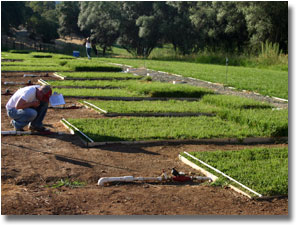
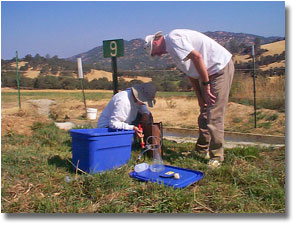
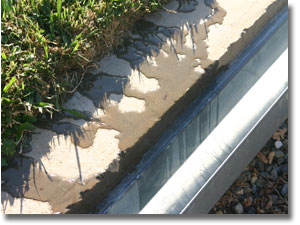
Small (6 yd2) runoff plots were dosed with cattle fecal pats, flood-irrigated at a low rate, to examine the nutrient (N, P, C) and chlorination disinfection byproducts in plots with a 0.1 and 2 yard wide buffer.
We found significant reductions in nutrient transport from buffered compared to non-buffered plots. This is primarily due to the 22% reduction in runoff from buffered plots. Reductions in dissolved organic carbon (DOC), particulate organic carbon (POC), dissolved organic nitrogen (DON) and nitrate (NO3) for the buffered plot were essentially due to the elimination of high runoff events compared to the non-buffered plots.

We found reduced transport of total P, phosphate, and THMFP
(chlorination disinfection by-product) from buffered plots, regardless of runoff volume.


DOC, POC, DON and nitrate transport reductions from buffered plots were due to the near elimination of high runoff events compared to non-buffered plots.
Management Significance
Vegetative filter strips can reduce the transport of nutrients (N – P – C) from irrigated pastures during irrigation events. Runoff rate is a major determinant of transport, the effectiveness of vegetative filter strips. Reduced tailwater generation through improved irrigation management will be a key factor in reducing nutrient transport from irrigated pastures. It is advisable to cut and remove buffer strip vegetation on some regular schedule (1 to 2 times per year).
Supporting Information
Bedard-Haughn, A., K.W. Tate, and C. van Kessel. 2005. Quantifying the Impact of Regular Cutting on Vegetative Buffer Efficacy for 15N sequestration. J. Environmental Quality. 34:1651-1664. Download
Bedard-Haughn, A., K.W. Tate, and C. van Kessel. 2004. Using 15N to Quantify Vegetative Buffer Effectiveness for Sequestering N in Runoff. J. Environmental Quality. 33:2252-2262. Download
